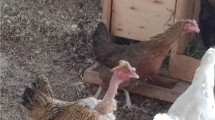Abstract
Social interactions among chickens can have a great unfavourable effect on economic returns in a poultry farm. The purpose of this study was to use four models to examine the influence of social genetic influences on the variation in body weight of Nigerian indigenous chickens. Sex was treated as the fixed effect within the models. Direct additive genetic, social genetic, and family effects and covariance between direct and social genetic effects were used as random effects. Data were analysed using single-trait animal models which include or exclude social genetic effects. Model comparison revealed that inclusion of full-sib family effect in model 3 did not cause any change in residual and additive genetic variances relative to estimates obtained with model 2. In general, social genetic variance was lower than the estimate for additive genetic variance, but substantially added to the overall heritable variance. For direct hereditary, full-sib family, and residual effects, accounting for heritable social effect in model 4 had a marginal effect on the size of the variances measured. All the estimated residual, additive genetic, social genetic effect, and family variances increased in comparison with model 3. The relationship between direct and social additive effects was positive and not significantly different from 0 (P > 0.05), suggesting autonomy between the direct and social breeding values. In conclusion, the use of models that account for direct effect and social genetic effect of the individual on its group members would entail an optimal individual selection scheme to increase the body weight of chickens.
Similar content being viewed by others
References
Alemu S.W., Berg P., Janss L. and Bijma P., 2014. Indirect genetic effects and kin recognition: estimating IGEs when interactions differ between kin and strangers. Heredity, 112: 197–206.
Alemu, S.W., Berg, P. Janss L. and Bijma, P., 2016. Estimation of indirect genetic effects in group-housed mink (Neovison vison) should account for systematic interactions either due to kin or sex. Journal of Animal Breeding and Genetics, 133: 43–50.
Arango, J., Misztal, I., Tsuruta, S., Culbertson, M. and Herring, W., 2005. Estimation of variance components including competitive effects of Large white growing gilts. Journal of Animal Science, 83:1241–1246.
Bergsma, R., Kanis, E., Knol, E.F. and Bijma, P., 2008. The contribution of social effects to heritable variation in finishing traits of domestic pigs (Sus scrofa). Genetics, 178: 1559-1570.
Bijma, P., 2010. Multilevel selection 4: modeling the relationship of indirect genetic effects and group size. Genetics, 186:1029–1031.
Bijma, P., Muir, W.M. and van Arendonk, J.A.M., 2007. Multilevel selection 1: quantitative genetics of inheritance and response to selection. Genetics, 175: 277–288.
Brinker, T., Raymond, B., Bijma, P., Vereijken, A. and Ellen, E.D., 2017. Estimation of total genetic effects for survival time in crossbred laying hens showing cannibalism using pedigree or genomic information. Journal of Animal Breeding and Genetics, 134:60–68.
Camerlink, I., Bolhuis, J., Duijvesteijn, N., van Arendonk, J.A.M. and Bijma, P., 2014. Growth performance and carcass traits in pigs selected for indirect genetic effects on growth rate in two environments. Journal of Animal Science, 92: 2612–2619
Cantet, R.J.C. and Cappa, E.P., 2008. On identifiability of (co)variance components in animal models with competition effects. Journal of Animal Breeding and Genetics, 125: 371–381.
Chen, C.Y., Kachman, S.D., Johnson, R.K., Newman, S. and Van Vleck, L.D., 2008. Estimation of genetic parameters for average daily gain using models with competition effects. Journal of Animal Science, 86: 2525-2530.
Chen, C.Y., Johnson, R.K., Newman, S., Kachman S.D. and Van Vleck L.D., 2009. Effects of social interactions on empirical response to selection for average daily gain of boars. Journal of Animal Science, 87: 844-849.
Duijvesteijn N., Knol E. F., Bijma P., 2012. Direct and associative effects for androstenone and genetic correlations between back- fat and growth in entire male pigs. Journal of Animal Science, 90: 2465-2475.
Ellen, E.D., Visscher, J., van Arendonk, J.A.M. and Bijma P., 2008. Survival of laying hens: genetic parameters for direct and associative effects in three purebred layer lines. Poultry Science, 87: 233–239.
Flisar, T., Malovrh, Š. and Kovač, M., 2015. The contribution of social group effect to variation in boars growth. PoljoPrivreda, 21(1):86-89.
Griffing, B., 1967. Selection in reference to biological groups I. Individual and group selection applied to populations of unordered groups. Australian Journal of Biological Science, 20:127–139.
Meyer, K., 2007. WOMBAT-A tool for mixed model analyses in quantitative genetics by restricted maximum likelihood (REML). Journal of Zhejiang University Science B, 8(11): 815–821.
Muir, W.M., 2005. Incorporation of competitive effects in forest tree or animal breeding programs. Genetics, 170:1247–1259.
Peeters, K, Eppink, T.T., Ellen, E.D., Visscher, J., Bijma, P., 2012. Indirect genetic effects for survival in domestic chickens (Gallus gallus) are magnified in crossbred genotypes and show a parent-of-origin effect. Genetics, 192:705–713.
Rostellato, R., Sartori, C., Bonfatti, V., Chiarot, G. and Carnier P., 2015. Direct and social genetic effects on body weight at 270 days and carcass and ham quality traits in heavy pigs. Journal of Animal Science, 93(1):1–10. https://doi.org/10.2527/jas.2014-8246.
Author information
Authors and Affiliations
Corresponding author
Ethics declarations
The manuscript does not contain clinical studies or patient data.
Statement of animal rights
All the protocols for this research were approved by the Animal Care and Use Committee of the Federal University of Agriculture, Abeokuta, Nigeria.
Conflict of interest
The authors declare that they have no conflict of interest.
Additional information
Publisher’s note
Springer Nature remains neutral with regard to jurisdictional claims in published maps and institutional affiliations.
Rights and permissions
About this article
Cite this article
Adenaike, A.S., Peters, S.O., Ogundero, A.E. et al. Contribution of social genetic effects in variance components estimation for body weight in Nigerian indigenous chickens raised in a tropical humid location. Trop Anim Health Prod 53, 124 (2021). https://doi.org/10.1007/s11250-021-02568-8
Received:
Accepted:
Published:
DOI: https://doi.org/10.1007/s11250-021-02568-8




